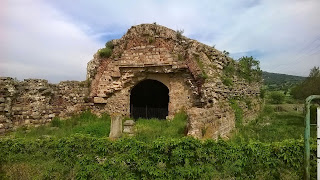Istanbul is currently the most populated city in Europe. It was chosen by Emperor Constantine I in the 4th century to become the 'New Rome' and for a thousand years it was the richest city in the Christian world.
In the 'New Rome' the Hippodrome chariot racing stadium replicates the Circo Massimo (in actual Rome) and the 'spina' central line is adorned with treasures from ancient Egypt and Greece. The Egyptian obelisk with hieroglyphs still incredibly sharp is only a third of its original height! Originally created in circa 1450BC in Egypt the obelisk was nearly 2000 years old when Constantine arranged its transfer to the Hippodrome.
Sultanhamet district in central Istanbul was once the site of a great Roman/Byzantine palace which in its time had no equal in Europe. Alongside the Palace and Hippodrome the church of Hagia Sophia still stands and is one of the world's greatest architectural achievements. Converted to a mosque in the 15th century by the Ottomans both Christian and Muslim influences are evident. It is truly a massive structure and the ancient mosaics within demonstrate fine and sensitive artwork. Turkey's first president Atatürk made it a museum in 1923.
So much more including the famous 'Blue Mosque' - a Muslim prayer building criticised for attempting to rival the architecture of Mecca itself. Constantine's column (Cemerlitas), the Basilica Cistern, Topkapi Palace, the Bosphorous and Golden Horn water ways and much more. The Catholic St Anthony of Padua in the Galatasaray district where I attempted to obtain a stamp for my (Via Frangicena) credential and, like in Rome, failed. The next day would have been possible!
To round this physical journey off a chance shortcut took us past the Milion. The stone pier fragment, on display in close vicinity to its original position, is what remains of the original Roman 'tetrapylon' - a once complex structure which defined the start point for all roads leading to cities within the Byzantine Empire. Fittingly, the start point (or end point) for the Via Egnatia.
Without the information made available to me through membership of the 'Confraternity of Pilgrims to Jerusalem' my engagement with the pilgrimage would have been much less. Thanks to those who have recorded or who have shared their research for their own journeys.
Finally, experiencing a little the culture and lifestyles of peoples on my journey has been remarkable. Daily communications with Sandra at home and her travelling to Istanbul to meet me have been hugely important.
Thanks for taking an interest.
In the 'New Rome' the Hippodrome chariot racing stadium replicates the Circo Massimo (in actual Rome) and the 'spina' central line is adorned with treasures from ancient Egypt and Greece. The Egyptian obelisk with hieroglyphs still incredibly sharp is only a third of its original height! Originally created in circa 1450BC in Egypt the obelisk was nearly 2000 years old when Constantine arranged its transfer to the Hippodrome.
Sultanhamet district in central Istanbul was once the site of a great Roman/Byzantine palace which in its time had no equal in Europe. Alongside the Palace and Hippodrome the church of Hagia Sophia still stands and is one of the world's greatest architectural achievements. Converted to a mosque in the 15th century by the Ottomans both Christian and Muslim influences are evident. It is truly a massive structure and the ancient mosaics within demonstrate fine and sensitive artwork. Turkey's first president Atatürk made it a museum in 1923.
So much more including the famous 'Blue Mosque' - a Muslim prayer building criticised for attempting to rival the architecture of Mecca itself. Constantine's column (Cemerlitas), the Basilica Cistern, Topkapi Palace, the Bosphorous and Golden Horn water ways and much more. The Catholic St Anthony of Padua in the Galatasaray district where I attempted to obtain a stamp for my (Via Frangicena) credential and, like in Rome, failed. The next day would have been possible!
To round this physical journey off a chance shortcut took us past the Milion. The stone pier fragment, on display in close vicinity to its original position, is what remains of the original Roman 'tetrapylon' - a once complex structure which defined the start point for all roads leading to cities within the Byzantine Empire. Fittingly, the start point (or end point) for the Via Egnatia.
Without the information made available to me through membership of the 'Confraternity of Pilgrims to Jerusalem' my engagement with the pilgrimage would have been much less. Thanks to those who have recorded or who have shared their research for their own journeys.
Finally, experiencing a little the culture and lifestyles of peoples on my journey has been remarkable. Daily communications with Sandra at home and her travelling to Istanbul to meet me have been hugely important.
Thanks for taking an interest.
































